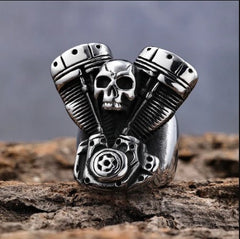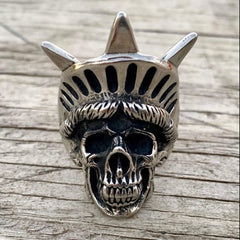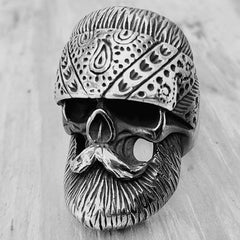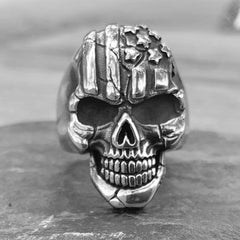Skull rings have been a powerful statement in various cultures throughout history, gracing the fingers of both the elite and the rebels. Skull jewelry in general is not just a trend; it's an enduring symbol that has carried multiple meanings over the centuries. From representing the acceptance of mortality to signifying victory over one's enemies, skull rings have become an iconic emblem. They signal a celebration of life as much as a reminder of death, and for many, they represent a memento mori—a reminder of the inevitability of death, encouraging the wearer to live life to the fullest. Whether crafted from silver, gold, or encrusted with jewels, these pieces of jewelry continue to captivate and express the complexities of human nature.
Symbolism of Skull Rings
Rebellion and Nonconformity
The act of wearing skull rings often transcends mere fashion and delves into the realm of personal statement, particularly one of rebellion and nonconformity. These rings can serve as a potent symbol for individuals who identify with counterculture movements or who wish to express their individuality and defiance of societal norms. In many instances, the skull and crossbones motif associated with pirates comes to mind—emblematic of a life led outside the confines of the mainstream. Hence, the skull ring becomes an instrument for the wearer to showcase their fearless spirit and renegade attitude. It becomes a visual declaration of difference, an emblem that one does not simply conform to accepted standards, but instead, carves their own path.
Mortality and Remembrance
The human skull, a symbol of our mortality, is a stark reminder that life is fleeting. This imagery, captured in the design of a skull ring, serves as a poignant memento that encourages reflection on the transient nature of existence. Skull rings symbolize more than just an end; they are often seen as tokens of enduring spirit and the idea of everlasting life after death. Wearing a skull ring can be a personal homage to loved ones lost, symbolizing not just the finality of death, but the cherished memories that remain. For some, these rings foster a connection to the past and a hope for legacy, suggesting that though life ends, the impact one makes can endure through time.
Protection and Strength
The symbolism of the skull ring extends further into realms of protection and strength. Often viewed as talismans, skull rings symbolize the strength to overcome challenges and the protection against adversities. For some, the skull acts as a guardian against evil spirits, with the belief that it can ward off malevolent forces and negative energy. This idea of the skull as a protective emblem finds a particular resonance among motorcycle gangs, where the skull ring is not just an accessory but a badge of resilience and brotherhood. The rings denote unity and strength within the group, fortifying members against both the physical dangers of the road and the existential threats of life. In this context, the skull embodies a potent force of safeguarding and courage, imbued with the spirit of protection.
History of Skull Rings
The origins of the skull ring are as eclectic as the cultures that embraced them; free spirits and rulers alike have adorned themselves with these symbols. Ancient civilizations held deep meanings for skull iconography, often embarking on a spiritual journey to understand the cycle of life and death. In some cultures, a skull ring was more than mere decoration; it served as a talisman to guide the wearer through the afterlife, ensuring protection and safe passage. Skull imagery found in artifacts across civilizations from the Egyptians to the Aztecs reflects a fascination and reverence for the concept of death—and in these societies, the wearing of skull rings may have signified status, power, or a deep understanding of life's ultimate transition. As time progressed, the skull maintained its powerful symbolism, while the rings themselves evolved into varied artistic representations embraced by different communities, always signifying a profound layer of existential depth.
As the skull ring transitioned into a fashion accessory, its evolution was marked by its adoption across a myriad of subcultures, each infusing it with new meaning. The potent symbolism of the skull design was embraced by the punk movement in the 1970s, where the skull ring became a token of the anti-establishment sentiment that defined the era. It continued to represent people on the fringes of society, serving as a visual lexicon of power and defiance. In the decades that followed, the gothic and heavy metal scenes championed the skull ring as part of their distinctive style, perpetuating its association with the powerful symbol of strength and an inexorable connection to the darker aspects of culture and music. Today, the skull ring continues to be reinvented, with high fashion brands adopting the motif, representing a fusion of luxury and the once solely rebellious nature of the skull, as it becomes a versatile emblem in the jewelry world.
Interpreting Skull Rings in Modern Context
In a modern context, the skull ring has evolved into a rebellious fashion statement, symbolizing edginess and freedom of expression. Celebrities have played a monumental role in cementing the skull ring's place in popular culture as a token of defiance and personality. Stars like Johnny Depp, Keith Richards, and Steven Tyler have frequently worn these iconic pieces, each adding a layer of rock 'n roll charisma to their public personas. The skull ring becomes more than just jewelry; it's a sign of their unapologetic individualism and enduring cool. Alexander McQueen, a brand synonymous with pushing the boundaries of fashion, has incorporated the skull motif into a range of designs, giving new meaning to the emblem by juxtaposing deathly symbolism with luxury and high fashion. The enthusiasm with which these pieces are flaunted by celebrities has undeniably contributed to the mainstream acceptance and popularity of skull rings as a personal expression of style.
Skull rings hold cultural significance that transcends their use in fashion and rebellion. Among the many traditions and religions where skulls play a pivotal role, Mexico's Day of the Dead, or "Dia de los Muertos," is particularly noteworthy. Skull imagery, including skull rings, symbolically celebrates this festival, where skulls represent not only the deceased but also the celebration of life. On this special day, the skull embodies the cycle of life and death in a joyful remembrance of lost loved ones, the colorful sugar skulls and skeletal figures serving as festive tokens of those who have passed on. In this context, the skull ring encapsulates both the somber remembrance of those no longer with us and the exuberance of Mexico's vibrant cultures.
Furthermore, skull rings continue to channel the ethos of nonconformity, often represents rebels through decades and across different societies. This universal emblem of defiance is embraced by those who identify with countercultural movements, who find in the stark image of the skull a kindred spirit for their own resolute individuality. As skull rings adorn the hands of many, they connect a diverse tapestry of beliefs and practices, each infusing the symbol with their own nuances and interpretations, making it not only a powerful icon of resistance but also a celebration of cultural diversity.
Skull Rings in Different Subcultures
In the realm of biker culture, the skull ring is not merely an accessory; it is an intrinsic part of a larger symbolic tapestry that reflects the ethos of living by one's own rules. For bikers, the skull ring is a bold declaration of freedom, independence, and a life led on the fringes of mainstream society. It's a visual affirmation of the biker's commitment to a brotherhood that thrives outside conventional norms, where the road is home and the rules are self-determined. This rebellious spirit envelopes the skull ring, transforming it into a totem of empowerment, a signal to the world that the biker lives life on his own terms, with the throttle in hand and destiny underfoot.
In contemporary men's fashion, the skull ring has emerged as a distinctive accessory that complements various styles, from the bespoke suits of discerning gentlemen to the casual attire of the streetwise urbanite. Men who wear skull rings often do so not just as a casual choice of jewelry, but as a bold statement of masculinity and strength. The hard lines and often hefty design of these rings lend a rugged touch to the wearer's ensemble, imbuing a sense of boldness and an edge that is synonymous with traditional masculine attributes. Indeed, the decision to wear a skull ring can be seen as an extension of one's persona, with the emblematic accessory acting as a silent herald of an assertive, confident presence that breaks away from the conformity of conventional fashion.
For jewelry enthusiasts and collectors, the allure of the skull ring transcends its edgy appearance; it is often pursued as a prized possession that reflects both personal taste and an appreciation for the craftsmanship behind skull jewellery. Collectors may seek out skull rings for their intricate designs, historied provenance, or the artisanal mastery required to sculpt such a complex symbol into a wearable piece of art. Each skull ring carries its own narrative, whether it be a hand-forged creation by a renowned jeweler or a vintage piece with a mysterious past. Connoisseurs of skull jewellery understand the skull ring as more than an accessory—it's a converging point of art, history, and identity, making each collection a unique reflection of the curator's aesthetics and values.
Silver Skull Rings Online at Sanity Jewelry
The skull ring endures as a multifaceted accessory with a rich tapestry of meanings, drawing in enthusiasts from varying backgrounds. As an iconic piece of skull jewelry, it is revered for its ability to signify nonconformity, the fragility of life, and a fearless embrace of individual expression. It mesmerizes the fashion-conscious, captivates collectors, and speaks to those entrenched in rebellious subcultures, each pursuing skull rings that resonate with their distinct narratives. From exuding rock 'n roll charisma to commemorating cultural festivals, the skull ring stands as a testament to diversity, bridging the gap between luxury fashion and symbols of defiance, continually adapting and thriving in the world of modern adornments.
Shopping for skull rings and other biker jewelry at Sanity Jewelry ensures that you're selecting from a collection that encapsulates the essence of the biker spirit in every piece. Whether you're searching for the perfect skull ring to complement your wardrobe or interested in expanding your jewelry collection with standout skull designs, Sanity Jewelry offers a plethora of choices. Crafted with detail-oriented precision, our sterling silver skull rings embrace a variety of styles that range from classic skull and crossbones to more intricate, contemporary patterns. Each piece is designed to make a powerful statement, reflecting a blend of toughness and artistry uniquely found in skull jewelry. At Sanity Jewelry, we understand the significance behind the symbolism and appreciate the importance of finding the perfect skull ring that resonates with an individual's style and personal narrative.
Frequently Asked Questions
What does it mean to wear skull rings on different fingers, like the ring finger versus the middle finger?
Wearing skull rings on different fingers can convey varied personal or cultural significance. In many cultures, the ring finger traditionally symbolizes commitment and love, while placing a skull ring on this finger could imply a deep connection to the ring's symbolism. Conversely, the middle finger is often associated with a bold attitude and individuality; wearing a skull ring on this finger might reflect an unapologetic sense of self or defiance against societal norms.
How does the material of a skull ring, such as sterling silver, affect its style and meaning?
Sterling silver is a highly versatile material that allows skull rings to be crafted in different styles ranging from sleek and modern to ornate and gothic. The sheen and durability of sterling silver give these rings a timeless quality and can often play into the meaning behind the ring—whether that's as a symbol of resilience, a precious keepsake, or a reflection of the wearer's own skin, hinting at their mortality and the transient nature of life.
Can you explain how skull rings might carry different meanings in different cultures?
Skull rings carry an assortment of meanings that differ among various traditions and societies. In some cultures, the skull is often a reminder of mortality and the importance of living a meaningful life, while in others, it can be seen as a protective charm or a symbol celebrating the memory of ancestors. The diverse interpretations of skull rings underscore the breadth of cultural attitudes towards the symbols of death and remembrance.
Are there different styles of skull rings? If so, what are some examples?
Yes, there are numerous styles of skull rings, each tailored to different personal tastes and cultural expressions. Some examples include minimalist designs that feature a simple, unadorned skull, while others may be more elaborate, incorporating elements like crossbones, floral patterns, or tribal motifs. You'll find that different styles can also feature adornments such as gemstones or engravings, which add a unique personality and flair to the jewelry.





